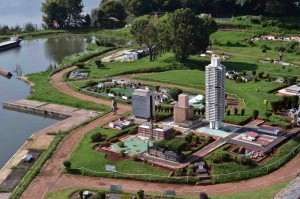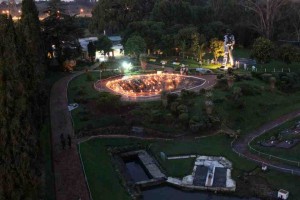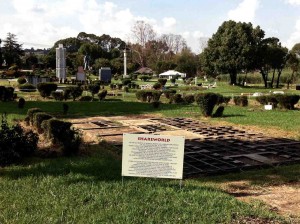The ideal of the panopticon
Naadira Patel
This is a short text which emerged out of a process of working in Santarama Miniland, in the south of Johannesburg, which attempts to unpack the complexities of scale, proportion, architecture, and what it means to intervene into history.
Sorry No Refunds
Welcome to The Desert of The Real
“You have now arrived in Miniland, in the same state as we found it when we first arrived. Please do not worry, a sense of disorientation and confusion is completely normal. Here in Santarama Miniland, parts of South Africa as well as historical events are re-represented in the form of miniature buildings and streets. This is the only place where Cape Town is a two-minute walk from Pretoria. You may come across some incongruity as buildings are the size of toys and people are the size of giants – when you get lost just look out for Michael Jackson, he’s a useful reference point…”
Excerpt from the introduction to (mis)guided tour – the (dis)simulated experience.
Take a step back. Fast forward
Santarama Miniland. A tiny land of wonder, just on the outskirts of the Johannesburg CBD, a time capsule of South Africa’s past. On first entry one is stunned and amazed by this Lilliputian version of South Africa. This childlike fascination, however, quickly gives way to a few hard hitting realities ; the South Africa constructed is one stuck in the 1970s. But this is a 1970s without townships, without black people, save for the quaintly fabricated ‘bantustans’ perched on a hilltop.
It is in some ways a theme park, a fantasyland, an apartheid utopia, a mish mash of iconic characters of a multiple moments in South Arica’s History – Michael Jackson, King Kong and a rather daunting statue of Jan van Riebeeck with life-sized Dromedaris. It may not necessarily be a theme park in the way we understand Disneyland or other prominent ‘amusement parks’ but it raises similar questions about how such spaces stand as markers of a specific place/time/political moment. Importantly, it raises the question of fantasy vs. reality. The ideal of the Panopticon. Space and time are compressed to give you a picture of the whole, bite-sized information in an afternoon stroll, or miniature-train ride.
Empire (Apartheid) State of Mind : The Map
Disjointed and disproportionate. Cape Town is next to Pretoria ; Table Mountain…. well they found a rock on a hill and added signage and some wires for a cable car ; the physical structure of Jan Smuts Airport bears the clumsily painted name O.R.Tambo ; Joburg is not Joburg, at least not a Joburg I have any reference to. Michael Jackson, 10m high donning the costume from his ’97 History Tour minus the embellishments.
This tiny land of wonder, an imaginative calculated mess, once set up as a fundraising strategy has fallen into the abyss of the forgotten and discarded, not dissimilar to the old Shareworld Amusement Park. While its remains, of-course, provide material to work with, it does not make interrogation or intervention easy.
What does this romantic landscape suggest about fantasy and reality ? Is it a spectacle staged to convince us of a particular history/moment that is REAL ? Is it a question of control ? Is it the Architect’s dream to shift/ move/ rotate/ increase/ decrease/include/remove and create the city as if one was playing with Lego blocks ?
Jean Baudrillard writes “It is the real, and not the map, whose vestiges persist here and therein the deserts that are no longer those of the empire, but ours. The desert of the real itself…” (Simulacra and Simulation, 1981) What we have are the scraps, leftovers and traces of a supposed real, a miniature and problematic South African history.
If the map precedes the territory, or no longer relies on it, therefore not imitated, then perhaps it is not disingenuous for the displays and dioramas to be disproportionate and exaggerated, simulated, embodied, carrying a life and meaning beyond that of representation. Miniland is a non-linear and multi-perspectival psycho-geography. A Fantasy. “…It is a hyperreal, produced from a radiating synthesis of combinatory models in a hyperspace without atmosphere.” (Simulacra and Simulation, 1981)
The question of intervention then is a complex one, where does one begin to pick/pry/dissect/interrogate an imagined landscape, without disregard for the history we ‘know’ ? If Miniland has any relation to a supposed real, it is as murky as the water in which a fibre glass shark sits propped up, jaws wide open, front teeth missing. “Ha ha, hy’s van die Kaap af mos !” someone jokes.
The ARTConnect project/residency, launched in September 2011 by VANSA, set out to invite young creatives to participate in a series of workshops concerned with exploring new approaches to creative work in the public realm, and was specifically concerned with animating public spaces in parts of Johannesburg that fall outside of the established circuits for contemporary art. The participants in ARTConnect were Zakara Raitt and Victoria Wigzell, Sikhumbuzo Makandula, Fulufhelo Mobadi and Naadira Patel. The Miniland projects and interventions were done in collaboration with Marie Fricout of the ESAD Strasbourg, 3rd year Design & Drawing students from the Wits School of Arts, and Fine Arts lecturers Zen Marie and Natasha Christopher.



